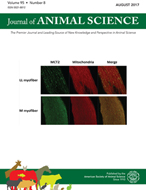-
Views
-
Cite
Cite
P. A. Foley, D. A. Kenny, J. J. Callan, T. M. Boland, F. P. O'Mara, Effect of DL-malic acid supplementation on feed intake, methane emission, and rumen fermentation in beef cattle, Journal of Animal Science, Volume 87, Issue 3, March 2009, Pages 1048–1057, https://doi.org/10.2527/jas.2008-1026
Close - Share Icon Share
ABSTRACT
The objective of this study was to determine the effect of dietary concentration of DL-malic acid (MA) on DMI, CH4 emission, and rumen fermentation in beef cattle. Two Latin square experiments were conducted. In Exp. 1, six beef heifers (19 ± 1 mo old) were assigned in a duplicated Latin square to 1 of 3 dietary concentrations of MA on a DMI basis (0%, MA-0; 3.75%, MA-3.75; or 7.5%, MA-7.5) over 3 periods. In Exp. 2, four rumen-fistulated steers (48 ± 1 mo old) were assigned to 1 of 4 dietary concentrations of MA (0%, MA-0; 2.5%, MA-2.5; 5.0%, MA-5.0; or 7.5%, MA-7.5) on a DMI basis, over 4 periods. Both experimental diets consisted of grass silage and pelleted concentrate (containing MA). Silage was fed ad libitum once daily (a.m.), whereas concentrate was fed twice daily (a.m. and p.m.) with the aim of achieving a total DMI of 40:60 silage:concentrate. In both Exp. 1 and 2, experimental periods consisted of 28 d, incorporating a 13-d acclimatization, a 5-d measurement period, and a 10-d washout period. In Exp. 1, enteric CH4, feed apparent digestibility, and feed intake were measured over the 5-d measurement period. In Exp. 2, rumen fluid was collected on d 16 to 18, immediately before (a.m.) feeding and 2, 4, 6, and 8 h thereafter. Rumen pH was determined and samples were taken for protozoa count, VFA, and ammonia analysis. Enteric CH4 emissions were estimated by using the sulfur hexafluoride tracer technique and feed apparent digestibility was estimated by using chromic oxide as an external marker for fecal output. In Exp. 1, increasing dietary MA led to a linear decrease in total DMI (P < 0.001) and total daily CH4 emissions (P < 0.001). Compared with the control diet, the greatest concentration of MA decreased total daily CH4 emissions by 16%, which corresponded to a 9% reduction per unit of DMI. Similarly, in Exp. 2, inclusion of MA reduced DMI in a linear (P = 0.002) and quadratic (P < 0.001) fashion. Increasing dietary MA led to a linear decrease in molar proportion of acetic (P = 0.004) and butyric acids (P < 0.001) and an increase in propionic acid (P < 0.001). Ruminal pH tended to increase (P = 0.10) with increasing dietary MA. Dietary inclusion of MA led to a linear (P = 0.01) decrease in protozoa numbers. Increasing supplementation with MA decreased CH4 emissions, but DMI was also decreased, which could have potentially negative effects on animal performance.





